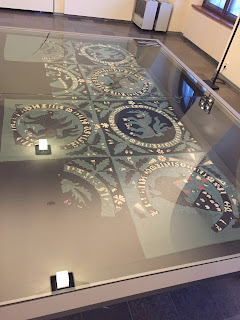I found a few bits of clothing that were probably pieced, including the Lorenzo Lotto Lucretia dress and started making those sorts of things so I could integrate my various interests. I considered a German persona because of the amazing pieces of what seem to be patchwork in some of their outfits.
 Then, I found the Imprunetta Cushion.and Lisa Evans' article in Medieval Clothing and Textiles 8 Anomaly or Sole Survivor? The Impruneta Cushion and Early Italian "Patchwork." Having an extant piece rather than just paintings of textiles that could be brocades or appliqued rather than pieced makes things so much easier to discuss.
Then, I found the Imprunetta Cushion.and Lisa Evans' article in Medieval Clothing and Textiles 8 Anomaly or Sole Survivor? The Impruneta Cushion and Early Italian "Patchwork." Having an extant piece rather than just paintings of textiles that could be brocades or appliqued rather than pieced makes things so much easier to discuss. 
So, I determined to make a copy of the cushion and started trying to find lots and lots of silk scraps for the front and lots and lots of wool scraps to do the back of an itty bitty tiny pillow. I plotted that for years and started it on 3 seperate occasions. As you can see from the only picture I have of the most recent version, it didn't go as well as would be hoped. This one was foiled by a kid eating on it, but that also pointed out a problem. I originally thought that I just wasn't being exact enough, despite how honestly persnickity I was being. There is a problem with the templates in the article. I was assuming the 8 long diamonds that form the center were symetrical both up and down and left to right. That's how they are analysed in Lisa Evans' article but the stars become domed if done with that shape. In order to have them flatten, the outer part of the diamond needs to be larger than the inner point. I also need to refine the outer curve of the long diamond that finishes the out of the shape. And I don't want to even talk about the shape of the 9 patch blocks that go between the stars. Basically, my math isn't up to drafting these.
I just am not skilled enough to do the tiny exacft work of the cushion without yelling and throwing things. So, I decided to do an intermediate project that is proof of concept and gets me started doing medieval style patchwork. Lisa Evans mentions several paintings with what are referred to as a Cloth of Honor. The major example she gives is of the Virgin with one behind her but there are other examples, including a country bride in a sceen by Brugel. Not all are patchwork, and those that appear to be could very well be brocade or something else,, but there is an extant Hungarian example that makes patchwork ones a possibility.
 I'll go into the Hungarian piece and the paintings more in the next post as I organize my documentation more, but mostly I want to talk about the progress on my own Cloth.
I'll go into the Hungarian piece and the paintings more in the next post as I organize my documentation more, but mostly I want to talk about the progress on my own Cloth.I started with a book of silk samples and have been peeling off the paper backings to cut my pieces. The material constraints meant I could only go so large with my pieces and that I needed a block that is graphic enough to work with darks and lights rather than needing exactly matching colors.. I wanted something with few pieces and not extensive math to calculate. Add to that a desire to evoke the stars of the Imprunetta cushion. Conveniently, I had a template for a spinning star that is a single piece but creates movement due to the curved pieceing. I have never used it before despite owning it for years.. Why? Because it cannot be machine pieced, the curves have to be done by hand. Since this is going to be an A&S entry, handpiecing was already a necessity and so its a good fit.
I pulled my silk out and began cutting the curved pieces. In the process, I ended up with more silk than I thought and was also able to cut out 2 inch squares. I decided to make these 4 patches, again to evoke the star and 9 patch of the extant cushion. The look gets closer to the paintings rather than the modern look of interlocking tesselating stars I started with, but it also requires more pieces to be a background. The fact that I was using thrifted and recycled silk so far made it so this particular project fit into a challenge I wanted to do (Ragged to Regal Challenge) and made me go looking for further reusable silk for the interstitial pieces. I found a white silk curtain and bought it for $1. The cloth is now closer to being something that can be draped behind a chair than the small square I started out which again makes it closer to the exemplars. It also makes it a lot more work. . .

I'm about 100 hours into it so far and still having fun. Even if it is no longer the "easy, proof of concept" project I started with. Its not going to be any easier than if I had done the cushion. But I'm this far in, still enjoying it, and excited about the results. I've got about 2/3 of the stars pieced, about to start cutting the white, and have all the 4 patch squares ready to go.







